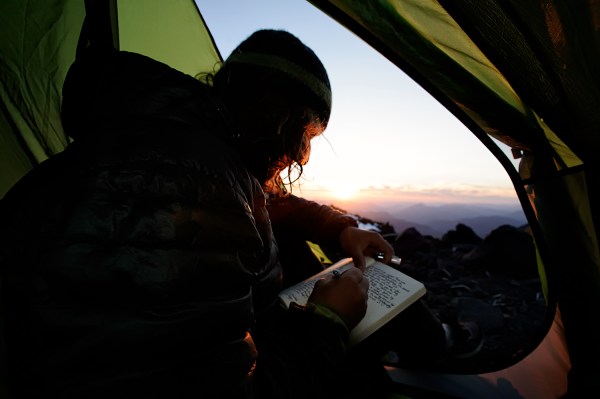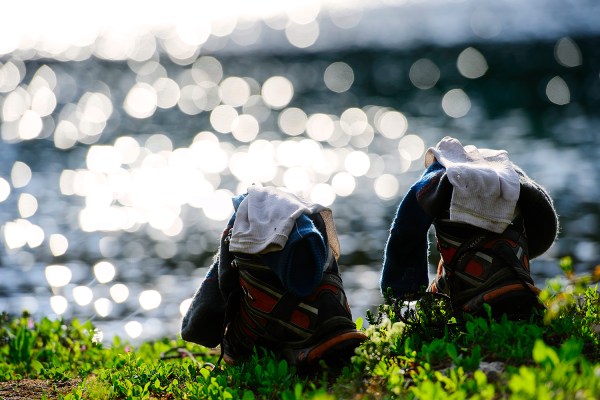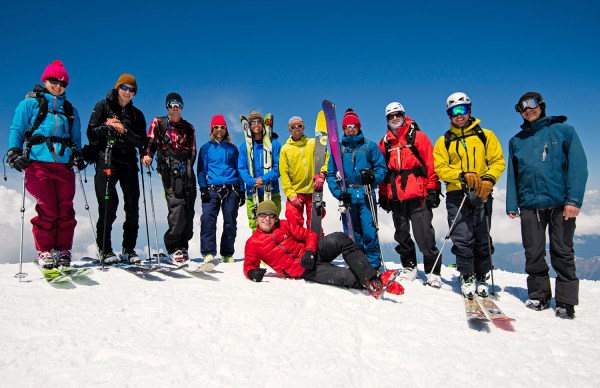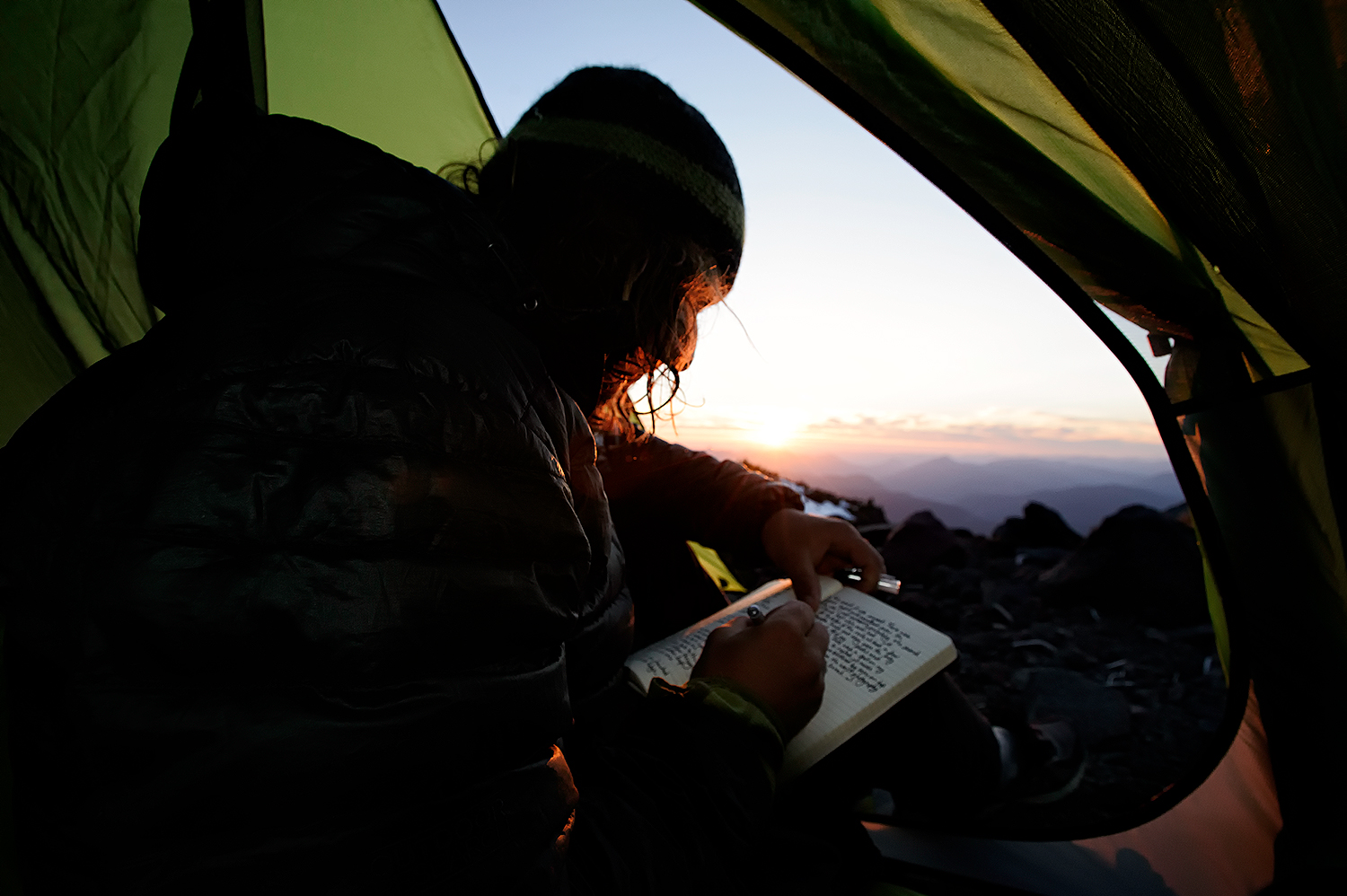When we explore pathways through the natural and manicured world by kayak, bike, foot, ski or other mode, we create experiences that enrich our daily lives.
Eventually we return to the office and our homes. We are no longer out there. Some of us want to memorialize that adventure. We want to share those invigorating experiences with family, friends, online communities and, someday, our grandchildren. For others, like me, creating something tangible is also a personal endeavor—a story for yourself first and foremost. No matter the reasons, the result enhances life beyond the week or weekend spent on the original quest. It invigorates the body and mind. The best of those adventures, you often want to remember. Here’s how to do it.
1. Keep a Journal

Adam Roberts writes about the day’s adventures after skiing the North Face NW Ridge of Mount Adams.
I keep mine in a waterproof bag with coloring pencils and pens. This allows me to record the fears, excitement and passion I had in the moment, as well as remembering what happened and where.
I begin each entry with the date, time of day and where I am. I’m not eloquent in my writing. I’m brief, trying to get as much data as I can on paper. I want to remember interactions and jot down quotes that I find interesting. To me, what I‘m recording is the framework of the story I will assemble later. This effort is especially helpful on longer adventures. How frustrating it can be to try to recall where you were on what day, who you met along the way, what you saw, etc. Without a journal, my memory quickly molds the entire trip into one long and never-ending day.
To escape that trap, write as much as you can, even if it is a sentence or two. It doesn’t take long. And if you do have time, a pen’s ink runs for miles. Use it up! Find that inner poet, your Emerson or Thoreau. Be eloquent. You never know what will inspire you when watching sunsets, standing on summits, staring at ocean waves or warming yourself by a fire.
2. Know Where You Are
Even in a big group, when you aren’t route-finding take a few moments every day to learn the names of the mountains, rivers, lakes, features, camps and history of the area. This can be from a guidebook, others you meet along the way, or historical markers that tell you more about the trailblazers who came before and what drove them. This is your connection to the past, just as your experience is a potential connection to someone else in the future.
3. Take Lots of Photos

We love visual props. I’m always careful to photograph not merely the most scenic parts of the trip, but the trail markers, camps and people. The little things like flowers, streams, rocks and gear. The big things like mountains, night skies, and camp seen from afar. Remember that you’re telling a story through imagery. These pictures are the breadcrumbs that lead people to read it.
Everyone has a camera preference. Many find a phone the best tool for the job. Others, a video camera, or a bigger digital SLR body and lenses. More recently, mirrorless cameras have been flooding the market with lighter, professional-quality cameras that can be perfect for some people’s adventures. Weight is always a consideration that’s hard to ignore.
No matter what camera you choose, keeping it handy is important. If decide to take your SLR with you, consider these tips for carrying a camera in the backcountry. If you have a phone or video cam, keep it in a dedicated place. Many packs have small pockets on their waist belts. If not, you can buy them. Have batteries and memory cards. Snap away!
4. Write About the Experience
Now that you have lived your adventure, it’s time to weave the imagery and words together. For some, writing just captions allows the imagery to speak for itself. For others, the tables are turned and words tell the tale. No matter what you decide to do: share. Take your journal notes, compile your imagery, pare it down to your favorites, and ultimately decide what you want to do with it all. Does it stay on your computer or do you share with others? I hope you share it. I, for one, love to hear about others’ adventures; they inspire my own.
5. Share the experience

Friends pose on the summit of Mount Baker, Washington.
If you want to connect with others who share your interests, there’s an array of local, sport-specific and general forums you can join. For example, in the Pacific Northwest we have NW Hikers for hiking, Turns All Year for backcountry skiing and Cascade Climbers for climbing.
How you share your content is up to you. Some people focus on conditions: How are the trails, how is the snow, are there any fallen logs, are the roads open, etc.? Others share the imagery. Some elaborate further and create webpages of their own.
These days it’s getting easier and easier to build a webpage. There are templates you can buy and interfaces that even the most technologically inept can master. Examples can be found on these sites: 1. Squarespace 2. Weebly 3. Wix 4. WordPress.
And finally, invite family and friends to see your story and photos. You can post a link and/or photos on Facebook, Twitter, Instagram and other social media.
